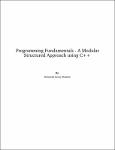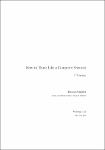Search
Author
- Jorgensen, Ed (3)
- McFadyen, Ron (3)
- Nora, El-Rashidy (3)
- Christian, Homeyer (2)
- next >
Subject
- programming (10)
- Open Access (8)
- Java (7)
- Programming (7)
- next >
Date issued
- 2020 - 2025 (293)
- 2010 - 2019 (39)
- 2000 - 2009 (2)
- 1999 - 1999 (1)
Has File(s)
- true (335)
Search Results
This text is a free introductory text that introduces MS Access and relational database design. The motivation is to support a second-year course on database systems which, to the student, is either a service course providing an introduction to database concepts, or, as a prerequisite for more advanced study in the field. |
Programming patterns are solutions to problems that require the creation of a small fragment of code that will be part of a larger program. Hence, this book is about teaching you how to write such fragments of code. However, it is not about teaching you the syntax of the statements in the fragments, it assumes that you already know the syntax. Instead, it is about finding solutions to problems that arise when first learning to program. |
This book is Part II of a two-part set that introduces the Java programming language. The text assumes the student will be using the BlueJ development environment and provides some introductory BlueJ material. Our experience has been that BlueJ is easy to learn and provides a good programming environment for the beginner programmer. |
"This second edition of Database Design book covers the concepts used in database systems and the database design process. Topics include:
The history of databases
Characteristics and benefits of databases
Data models
Data modelling
Classification of database management systems
Integrity rules and constraints
Functional dependencies
Normalization
Database development process
New to this edition are more examples, highlighted and defined key terms, both throughout and at the end of each chapter, and end-of-chapter review exercises. Two new chapters have been added on SQL, along with appendices that include a data model example, sample ERD exercises and SQL lab with solutions" |
"Programming Fundamentals - A Modular Structured Approach using C++ is written by Kenneth Leroy Busbee, a faculty member at Houston Community College in Houston, Texas. The materials used in this textbook/collection were developed by the author and others as independent modules for publication within the Connexions environment. Programming fundamentals are often divided into three college courses: Modular/Structured, Object Oriented and Data Structures. This textbook/collection covers the first of those three courses.
The learning modules of this textbook/collection were written as standalone modules. Students using a collection of modules as a textbook will usually view it contents by reading the modules sequentially as presented by the author of the collection.
The learning ... |
The purpose of this text is to provide a reference for University level assembly language and systems programming courses. Specifically, this text addresses the x86-64 instruction set for the popular x86-64 class of processors using the Ubuntu 64-bit Operating System (OS). While the provided code and various examples should work under any Linux-based 64-bit OS, they have only been tested under Ubuntu 14.04 LTS (64-bit). The x86-64 is a Complex Instruction Set Computing (CISC) CPU design. This refers to the internal processor design philosophy. CISC processors typically include a wide variety of instructions (sometimes overlapping), varying instructions sizes, and a wide range of addressing modes. The term was retroactively coined in contrast to Reduced Instruction Set Computer (RISC... |
"We set out to design an introductory course governed by four themes:
Give students a good idea of what a career in MIS looks like by doing MIS.
Enhance the professionalism of deliverables by teaching design and usability concepts.
Promote creativity by assigning projects that demand it.
Teach students about cloud computing by having them do cloud computing.
Students in an introductory Management Information Systems (MIS) course often ask what a career in MIS looks like. Lacking a clear vision, they make their own assumptions. Often they assume the career involves programming with little human interaction. That MIS is a technical field could not be further from the truth. MIS job descriptions typically require candidates to be able to collaborate, communicate, analyze needs a... |
Computers are everywhere in our daily lives. Between the desktop, laptop, phone, bank, and vehicle, it is difficult to completely get away from computers. It only makes sense to learn a little about how a computer really works.This text provides an introduction to programming and problem solving using the Fortran 95/2003/2008 programming language. This introduction is geared for non-computer science majors. The primary focus is on an introduction to problem solving and algorithm development. As such, many details of the Fortran 95/2003/2008 language are omitted. |
"The title of this book was originally Think Perl 6, but since Perl 6 has been renamed Raku, we have also changed the title of the book.
Think Raku is an introduction to computer science and programming intended for people with little or no experience.
This aim of this book is not primarily to teach Raku, but instead to teach the art of programming, using the Raku language. After having completed this book, you should hopefully be able to write programs to solve relatively difficult problems in Raku, but my main aim is to teach computer science, software programming, and problem solving rather than solely to teach the Raku language itself.
Think Raku is a free book available under a Creative Commons license. Readers are free to copy and distribute the text; they are also ... |
The goal of this book is to teach you to think like a computer scientist. I like the way computer scientists think because they combine some of the best features of Mathematics, Engineering, and Natural Science. Like mathematicians, computer scientists use formal languages to denote ideas (specifically computations). Like engineers, they design things, assembling components into systems and evaluating trade offs among alternatives. Like scientists, they observe the behavior of complex systems, form hypotheses, and test predictions.The single most important skill for a computer scientist is problem-solving. By that I mean the ability to formulate problems, think creatively about solutions, and express a solution clearly and accurately. As it turns out, the process of learning to prog... |










